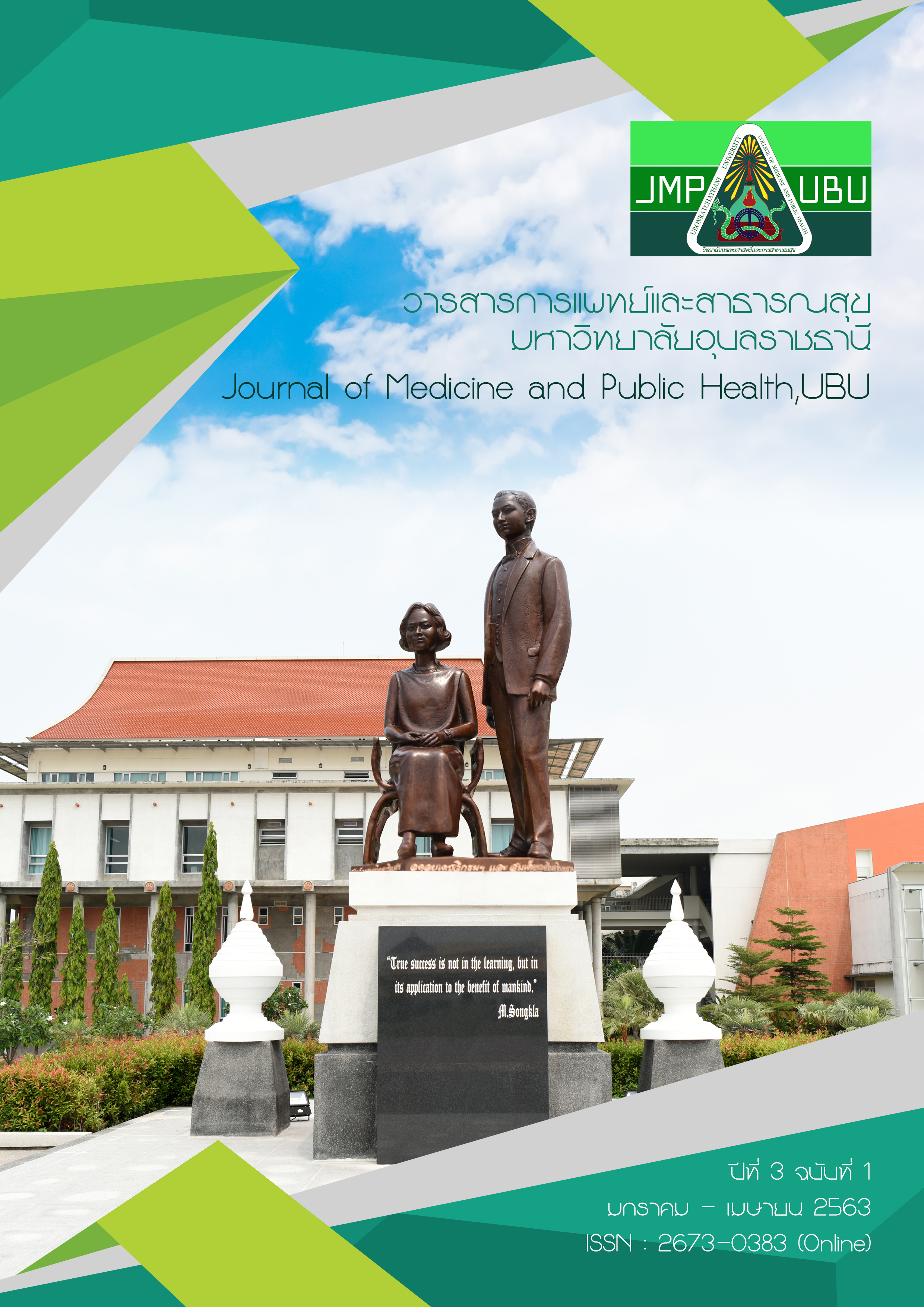การพยาบาลผู้ป่วยติดเชื้อในกระแสเลือดร่วมกับภาวะไตวายเฉียบพลัน : กรณีศึกษา
คำสำคัญ:
ภาวะติดเชื้อในกระแสเลือด, ภาวะไตวายเฉียบพลัน, ทฤษฏีของเพนเดอร์บทคัดย่อ
ปัญหาภาวะการติดเชื้อในกระแสเลือดนับเป็นปัญหาสำคัญทางด้านสาธารณสุข เพราะกระทบต่อชีวิตของประชาชน ทำให้เจ้าหน้าที่สาธารณสุขต้องให้ความตระหนักและเล็งเห็นถึงความจำเป็นของการวางแผนการดูแลผู้ป่วยกลุ่มนี้ การศึกษานี้เป็นการศึกษารายกรณี มีวัตถุประสงค์เพื่อส่งเสริมให้ผู้ป่วยที่มีภาวะการติดเชื้อในกระแสเลือดร่วมกับภาวะไตวายเฉียบพลันได้รับการดูแลที่ถูกต้อง เหมาะสม และปลอดภัยจากภาวะแทรกซ้อนต่าง ๆ ศึกษาในผู้ป่วยที่ติดเชื้อในกระแสเลือดร่วมกับมีภาวะไตวายเฉียบพลันเป็นระยะเวลา 3 เดือน (มิถุนายน-สิงหาคม 2562) ในรูปแบบกรณีศึกษาของ ผู้ป่วยชายไทยอายุ 35 ปี มาโรงพยาบาลด้วยอาการไข้ ปวดศีรษะ เหนื่อยเพลีย เป็นมา 2 วัน ประเมินอาการที่ตอบสนองต่อการอักเสบทั่วร่างกาย (systemic inflammatory response syndrome: SIRS) พบว่ามีไข้และพบเม็ดเลือดขาวมีค่าเท่ากับ 14,200 u/L ร่วมกับการประเมินความรุนแรงด้วย search out severity (SOS) score เท่ากับ 2 ผลการศึกษา พบว่าผู้ป่วยมีปัญหาหลัก 5 ข้อ คือ 1. ภาวะช็อกจากการติดเชื้อในกระแสเลือด 2. มีภาวะของเสียคั่งในร่างกายเนื่องจากไตสูญเสียหน้าที่ในการกรองอย่างเฉียบพลัน 3. ผู้ป่วยไม่สุขสบายเนื่องจากปวดศีรษะและปวดเมื่อยตามตัว 4. มีโอกาสเกิดภาวะขาดสารน้ำและสารอาหารเนื่องจาก เหนื่อย เพลีย รับประทานอาหารได้น้อย 5. ผู้ป่วย/ญาติมีความวิตกกังวลเกี่ยวกับอาการเจ็บป่วย โดยผู้ศึกษาได้นำทฤษฏีของเพนเดอร์ ตามแนวคิดความเชื่อในพฤติกรรมส่งเสริมสุขภาพของคน มาใช้ในการดูแลผู้ป่วยรวมกับการรักษาตามมาตรฐาน เพื่อช่วยให้ดูแลผู้ป่วยได้ครอบคลุมยิ่งขึ้น ทำให้ผู้ป่วยหายและจำหน่ายกลับบ้านได้ภายใน 4 วัน สิ่งสำคัญที่พยาบาลจะต้องตระหนัก คือ การประเมินภาวะฉุกเฉิน การช่วยเหลืออย่างทันที การให้ข้อมูลที่ถูกต้องชัดเจน ตลอดจนการให้คำแนะนำเพื่อปฏิบัติตัวเมื่อกลับบ้าน การรับประทานยา และการสังเกตความผิดปกติที่ควรรีบมาพบแพทย์ เพื่อที่จะทำให้ผู้ป่วยสามารถมีคุณภาพชีวิตที่ดี ซึ่งรายงานการศึกษานี้สามารถใช้เป็นแนวทางสำหรับพยาบาลในการให้การพยาบาลแบบองค์รวมแก่ผู้ป่วยที่มีภาวะติดเชื้อในกระแสเลือดร่วมกับภาวะไตวายเฉียบพลันต่อไป
Downloads
เอกสารอ้างอิง
Nguyen HB, Rivers EP, Abrahamian FM, Moran GJ, Abraham E, Trzeciak S, et al. Severe sepsis and septic shock: review of the literature and emergency department management guidelines. Ann Emerg Med. 2006; 48(1): 28-54.
ทิฏฐิ ศรีวิสัย, วิมล อ่อนเส็ง. ภาวะช็อกจากการติดเชื้อ: ความท้าทายของพยาบาลฉุกเฉิน. วารสารวิทยาลัยพยาบาลบรมราชชนนี อุตรดิตถ์. 2560; 9(2): 152-162.
Yende S, Austin S, Rhodes A, Finfer S, Opal S, Thompson T, et al. Long-term quality of life among survivors of severe sepsis: analyses of two international trials. Crit Care Med. 2016; 44(8): 1461-67.
Starr ME, Saito H. Sepsis in old age: review of human and animal studies. Aging Dis. 2014; 5(2): 126-36.
โรงพยาบาลวังหิน จังหวัดศรีสะเกษ. สรุปข้อมูลเวชระเบียนผู้ป่วยใน ปี 2562. โรงพยาบาลวังหิน จังหวัดศรีสะเกษ. ศรีสะเกษ; 2562
Dugar S, Choudhary C, Duggal, A. Sepsis and septic shock: Guideline-based management. Cleveland Clinic Journal of Medicine. 2020; 87(1): 53-64.
Rhodes A, Evans LE, Alhazzani W, Levy MM, Antonelli M, Ferrer R, et al. Surviving sepsis campaign: international guidelines for management of sepsis and septic shock: 2016. Crit Care Med. 2017; 43(3): 486-552.
Lopes JA, Jorge S, Resina C, Santos C, Pereira Á, Neves J, et al. Acute renal failure in patients with sepsis. Critical Care. 2007; 11(2): 411.
Pender, N. Health promotion model manual [online]. Available from: https://deepblue.lib. umich.edu/bitstream/handle/2027.42/85350/HEALTH_PROMOTION_MANUAL_Rev_5-2011.pdf? sequence=1&isAllowed=y [cited 24 April 2020].
กรรณิกา อำพนธ์, ชัชญาภา บุญโยประการ, พัชรินทร์ ศิลป์กิจเจริญ. ผลลัพธ์ของการพัฒนาการดูแลผู้ป่วยติดเชื้อในกระแสเลือดโรงพยาบาลพระปกเกล้า. วารสารศูนย์การศึกษาแพทยศาสตร์คลินิก โรงพยาบาลพระปกเกล้า 2559; 34 (3): 222-236.
นงลักษณ์ โค้วตระกูล. ผลการพัฒนาคุณภาพระบบการจัดการผู้ป่วยรายกรณีติดเชื้อในกระแสเลือดของโรงพยาบาลสมเด็จพระยุพราชสระแก้ว. วารสารพยาบาลโรคหัวใจและทรวงอก 2557; 25(2): 120-134.
นนทรัตน์ จำเริญวงศ์, สุพรรณิการ์ ปิยะรักษ์, ชยธิดา ไชยวงษ์. การประเมินและการพยาบาลผู้ป่วยที่มีภาวะช็อกจากการติดเชื้อในกระแสเลือด. วารสารเครือข่ายวิทยาลัยพยาบาลและการสาธารณสุขภาคใต้. 2563; 7(1): 319-330.
คมกฤช สุทธิฉันท์, มยุรี พิทักษ์ศิลป์, สมจิต พฤกษะริตานนท์. ผลลัพธ์ของการใช้เกณฑ์การประเมิน อวัยวะล้มเหลวเนื่องจากภาวะติดเชื้อในกระแสเลือดแบบเร็วเปรียบเทียบกับเกณฑ์กาประเมินผู้ป่วยภาวะติดเชื้อในกระแสเลือดของจังหวัดฉะเชิงเทราในผู้ป่วยติดเชื้อที่โรงพยาบาลบางปะกง. บูรพาเวชสาร. 2561; 5(1): 13-27.
พรนภา วงศ์ธรรมดี, รัชนี นามจันทรา, วารินทร์ บินโฮเซ็น. คุณภาพการจัดการดูแลผู้ที่มีภาวะติดเชื้อในกระแสเลือดที่หน่วยงานอายุรกรรม. วารสารการพยาบาลและสุขภาพ สสอท. 2562; 1(1): 33-49.
ดาวน์โหลด
เผยแพร่แล้ว
รูปแบบการอ้างอิง
ฉบับ
ประเภทบทความ
สัญญาอนุญาต
เนื้อหาและข้อมูลในบทความที่ลงตีพิมพ์ในวารสารการแพทย์และสาธารณสุข มหาวิทยาลัยอุบลราชธานี ถือเป็นข้อคิดเห็นและความรับผิดชอบของผู้เขียนบทความโดยตรง ซึ่งกองบรรณาธิการวารสารไม่จำเป็นต้องเห็นด้วย หรือร่วมรับผิดชอบใด ๆ
บทความ ข้อมูล เนื้อหา รูปภาพ ฯลฯ ที่ได้รับการตีพิมพ์ในวารสารการแพทย์และสาธารณสุข มหาวิทยาลัยอุบลราชธานี ถือเป็นลิขสิทธิ์ของวารสารการแพทย์และสาธารณสุข มหาวิทยาลัยอุบลราชธานี กองบรรณาธิการไม่สงวนสิทธิ์ในการคัดลอกเพื่อการพัฒนางานด้านวิชาการ แต่ต้องได้รับการอ้างอิงที่ถูกต้องเหมาะสม






